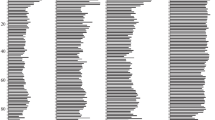Summary
The thickness of the bed sediment 5·70 m of the Mikolajki Lake (Central Mazur District) was measured at a depth of 18·5 m by means of a vertical core sampler.
In the samples taken from this profile the amount of sedimentary chlorophyll in relation to the dry mass of the sediment, the percentage of organic matter content and the absolute water content were determined.
From analyses of the amount of sedimentary chlorophyll and organic matter in the Mikolajki Lake sediment, two stages in the development of the lake during the post-glacial period were distinguished which in their general outline corresponded to the climatic changes described byBlytt andSernander. During the periods when the climate was cold and humid the proportion of sedimentary chlorophyll and organic matter was smaller than during the periods of dry and warm climatic conditions when the lakes frequently became, for example during the boreal period. In addition, the author suggests that two layers originating from the humid period and two layers from the dry periods may be distinguished in the upper part of the profile. The former two would seem to correspond to the subatlantic period, the two latter to the neoboreal period.
Similar content being viewed by others
References
Asklund, B., andSandegren, R.,Beskrivning till Kartbladet storvik, Sverig. Geolog. Unders, Ser. A.176 (1934).
Blytt, A.,Zur Geschichte der Nordeuropäischen. Flora, Englers Bot. Jb. System17 (1893).
Bradley, W. H.,Paleolimnology, in: David G. Frey, Editor, Limnology in North America (University of Wisconsin Press), Madison6, Wisconsin, 621–652 (1963).
Czeczuga, B.,Zawartosc chlorofilu w osadach dennych jezior Rajgrodzkich w okresie polodowcowym, Polskie Arch. Hydrobiolog.6 (1959).
Deevey, E. S.,Radiocarbon dating, Sc. Am.186 (1952).
Deevey, E. S. Paleolimnology and climate, 273–318, in: ‘Climatic Change’, ed. Harlov Shapey; Cambridge, Mass. Harvard Univ. Press (1953).
Deevey, E. S.,The obliteration of the hypolimnion, Mem. Ist. Ital. Idrobiol. Suppl.8 (1955).
Fogg, G. E., andBelcher, J. H.,Pigments from the Botom Deposits of an English Lake, New Phytologist60 (1961).
Granlund, E.,De svenska högmossarnas geologi, Sverig. Geolog. Unters. Arsbok, ser. C.26 (1932).
Hardy, E. M.,The Shropshire and Flint Maelor Mosses, New Phytologist38 (1939).
Hutchinson, G. E., andVallentyne, J. R. W.,New Approaches to the Study of Lake Sediments, Verh. int. Ver. Limnol.12 (1955).
Korde, N. W.,Znaczenije biologiczeskich pokazatielej pri izuczenia sapropielewych otlozenij i ispolzowanije etich pokazatielej dla datirowki otlozenij holocena, Trudy Labor. Saprop. otloz.7 (1959).
Korde, N. W.,Biostratifikacja i tipologija russkich sapropielej (Moskwa 1960), 219.
Kosicki, S.,Pionowe rozmieszczenie wrotków pelagicznych w okresie stagnacji letniej w jeziorach Mikolajskim i Sniardwy, Polskie Arch. Hydrobiol.8 (1960).
Kozlowskaja, L. S. K woprosu o geniezisie ozior sredniej polosy jewropejskoj czasti, SSSR, Trudy Lab. Saprop. Otloz.7 (1959).
Nilsson, T.,Die pollenanalitische Zonengliederung der spät- und postglazialen Bildungen Schonens, Geolog. Förening i Stockholm Förhandl.57 (1935).
Pennington, W.,Lake Sediments the Bottom Deposits of the North Basin of Windermere ... etc., New Phytolog.42 (1943).
Pjawczenko, N. I.,≪Niznija≫ jel w torfienikach, Tr. Inst. lesa A. N. SSR36 (1957).
Sernander, R.,On the Evidences of Postglacial Changes of Climate Furnished by the Peat-Mosses of Northern Europe, Geol. Fören. i Stockholm Förh.30 (1908).
Sukaczow, W. N., andPoplawskaja, G. I.,Oczierk istorii ozior i rastitielnosti Sredniego Urala w tieczenije holocena po danym izuczenija sapropielewych otlozenij, Biull. Komitieta po izuczeniju czetwierticznogo pierioda8 (1946).
Tidelski, F.,Untersuchungen über spät- und postglaziale Ablagerungen in Becken der kuppigen, Grundmoränenlandschaft Schleswig-Holsteins, Arch. Hydrobiol.20 (1929).
Vallentyne, J. R.,Sedimentary chlorophyll determination as a paleobotanical method, Canad. J. Bot.33 (1955).
Vallentyne, J. R.,epiphasic Carotenoids in Postglacial Lake Sediments, Limn. Oceanogr.1 (1956).
Wieckowski, K.,Improved Vertical Core Sampler for Collecting the Bottom Sediments Monoliths, Bull. L'Acad. Pol. Ser. geol. et geogr.9 (1961).
Züllig, H.,Sedimente als Ausdruck des Zustandes eines Gewässers, Mem. Ist. Ital. Idrobiol. Suppl.8 (1955).
Züllig, H.,Sedimente als Ausdruck des Zustandes eines Gewässers, Schweiz. Z. Hydrol.18 (1956).
Züllig H.,Das kombinierte Ramm-Kolben-Lot, ein leichtes Bohrgerät zur vereinfach ten Gewinnung mehrerer Meter langer ungestörter Sedimentprofile, Schweiz. Z. Hydrol.18 (1956).
Züllig, H.,Die Bestimmung von Myxoxanthophyll in Bohrprofilen zum Nachweis vergangener Blaualgenentfaltungen, Verhandl. Internat. Verein. theoret. angew. Limnol.14 (1961).
Author information
Authors and Affiliations
Rights and permissions
About this article
Cite this article
Czeczuga, B. Quantitative changes in sedimentary chlorophyll in the bed sediment of the Mikolajki Lake during the post-glacial period. Schweiz. Z. Hydrologie 27, 88–98 (1965). https://doi.org/10.1007/BF02505394
Received:
Issue Date:
DOI: https://doi.org/10.1007/BF02505394




